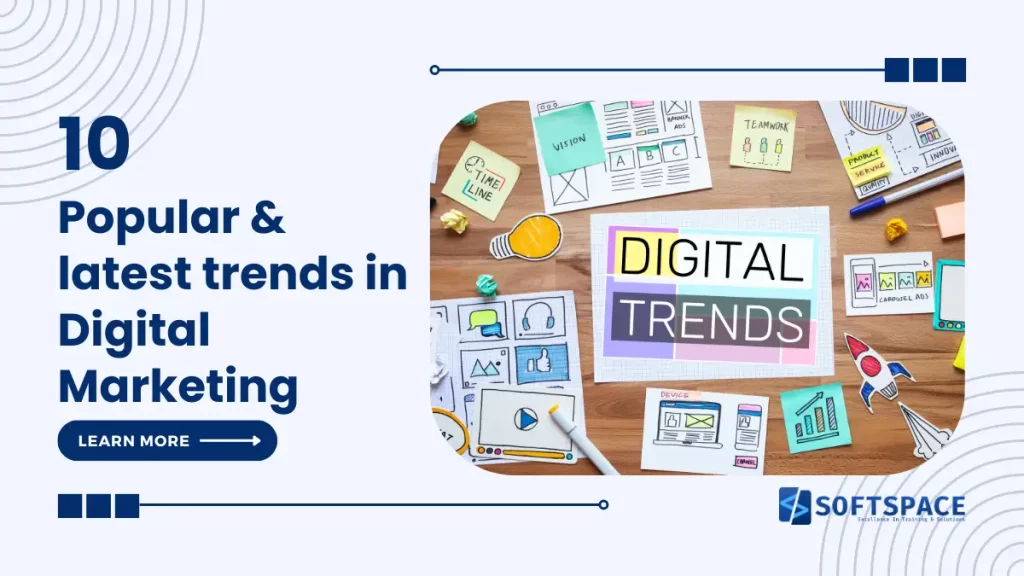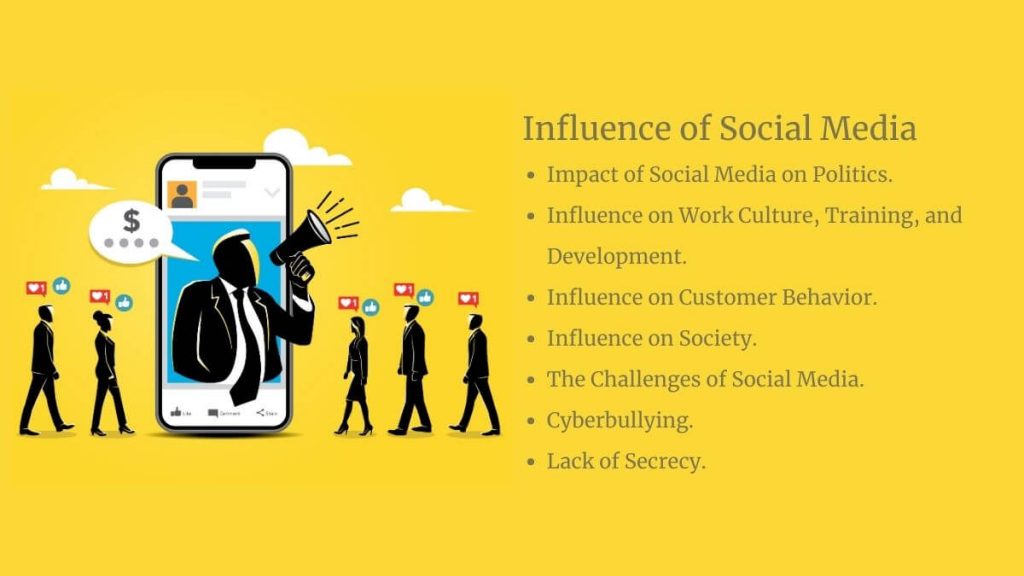Are you looking to stay up-to-date with the latest trends in digital marketing? Look no further! In this ultimate 2024 guide, we will explore the top 10 latest digital marketing trends that are shaping the digital marketing landscape. From personalization and video marketing to influencer marketing and chatbots, we’ve got you covered.
Whether you’re a marketing professional or a business owner, this guide will provide valuable insights and actionable tips for success in the digital world. So let’s dive in and discover how you can stay ahead of the curve by knowing the latest trends in Digital Marketing!
Table of Contents
In an ever-evolving digital landscape, staying ahead of the game with these latest trends in digital marketing is crucial for businesses to thrive. With the rapid advances in technology, it’s vital to keep up with the latest digital marketing trends to remain competitive. In this article, we delve into the 10 latest trends in digital marketing for 2024 that will shape the way we connect, engage, and convert our audiences.
From artificial intelligence and voice search to immersive video marketing and personalized content, these trends are set to revolutionize the way brands interact with their customers. We explore how AI-driven chatbots can enhance customer service, how voice search optimization can boost organic rankings, and how immersive video experiences can captivate and convert audiences.
By incorporating these emerging trends into their digital marketing strategies, brands can effectively reach their target audience, boost brand awareness, and drive conversions. Whether you’re a small business owner or a seasoned marketer, this article will provide valuable insights to help you stay ahead in the rapidly evolving digital marketing landscape of 2024.
The Latest Trends in Digital Marketing in 2024
Digital marketing is constantly evolving, and staying ahead of the game is crucial for businesses to thrive in this competitive landscape. By keeping up with the latest trends and technologies, brands can effectively reach their target audience, boost brand awareness, and drive conversions. With the rapid advances in technology, it’s more important than ever to embrace emerging trends and adapt to changing consumer behaviors.
In today’s digital age, consumers have access to a wealth of information and options at their fingertips. They are becoming more discerning and expect personalized and engaging experiences from brands. By staying ahead in digital marketing, businesses can effectively connect with their audience, build meaningful relationships, and stay top of mind.
Moreover, staying ahead in digital marketing allows businesses to leverage new technologies and platforms to gain a competitive edge. By embracing emerging trends, brands can tap into new markets, explore innovative marketing strategies, and differentiate themselves from their competitors.
In summary, staying ahead in digital marketing is crucial for businesses to thrive in today’s competitive landscape. By keeping up with the latest trends and technologies, brands can effectively connect with their audience, build meaningful relationships, and gain a competitive edge.
Trend 1: Artificial Intelligence and Machine Learning
Artificial Intelligence (AI) and Machine Learning (ML) are revolutionizing the way businesses operate and interact with their customers. AI-powered chatbots, for example, are becoming increasingly popular in customer service.
These chatbots can provide instant and personalized assistance to customers, improving their overall experience. They can answer frequently asked questions, provide product recommendations, and even process transactions.
Additionally, AI and ML can help businesses analyze vast amounts of data to gain valuable insights into customer behavior and preferences. By understanding their audience better, brands can create targeted marketing campaigns that resonate with their customers.
The impact of AI on digital marketing is that it can also enhance personalization efforts by delivering customized content and recommendations based on individual preferences and past interactions.
In conclusion, AI and ML are transforming the way businesses interact with their customers. By leveraging these technologies, brands can provide personalized experiences, improve customer service, and gain valuable insights into customer behavior.
Trend 2: Voice Search Optimization
Voice search has become increasingly popular with the rise of voice-enabled devices such as smart speakers and virtual assistants. As more consumers turn to voice search to find information and make purchases, optimizing for voice search has become essential for businesses.
To optimize for voice search, businesses need to understand how people use voice commands and tailor their content accordingly. Voice search queries tend to be more conversational and longer than traditional text queries. Therefore, businesses should focus on creating content that answers specific questions and provides concise, relevant information.
Additionally, businesses should ensure that their websites are mobile-friendly and load quickly, as voice searches are often performed on mobile devices. Optimizing for local search is also crucial, as voice searches often include location-based queries.
In summary, voice search optimization is a trend that businesses cannot afford to ignore. By optimizing their content and website for voice search, brands can improve their organic rankings, reach a wider audience, and stay ahead of the competition.
Trend 3: Video Marketing
Video marketing has been on the rise for several years, and it continues to be a dominant trend in the digital marketing landscape. With the popularity of platforms like YouTube, TikTok, and Instagram Reels, video has become an essential tool for brands to engage and connect with their audience.
Immersive video experiences, such as 360-degree videos and virtual reality (VR) content, are gaining traction among consumers. These experiences allow brands to create interactive and memorable experiences that captivate and convert audiences. For example, a virtual reality tour of a hotel can give potential guests a realistic preview of the rooms and facilities, increasing the likelihood of bookings.
Moreover, live video streaming has become a powerful marketing tool for businesses. Platforms like Facebook Live and Instagram Live allow brands to interact with their audience in real time, answer questions, and showcase products or services. Live videos create a sense of urgency and exclusivity, driving engagement and conversions.
In conclusion, video marketing remains a hot trend in digital marketing. By incorporating immersive video experiences and leveraging live video streaming, brands can effectively engage and convert their audience, ultimately driving business growth.
Trend 4: Influencer Marketing
Influencer marketing has become a staple in the digital marketing strategies of many brands. By collaborating with influencers, brands can tap into their large and engaged audience to promote their products or services. Influencers have built a level of trust and credibility with their followers, making their recommendations highly influential.
In recent years, micro-influencers have gained popularity due to their niche focus and high engagement rates. These influencers have smaller but highly targeted audiences, making them ideal for brands looking to reach specific demographics or niche markets.
Brands are also increasingly turning to nano-influencers, who have even smaller but highly engaged followings. Nano-influencers often have a more personal connection with their audience, making their recommendations even more influential.
To succeed in influencer marketing, brands need to carefully choose influencers who align with their values and target audience. Authenticity is key, as consumers can quickly sense when a collaboration feels forced or inauthentic. By partnering with influencers who genuinely love and use their products or services, brands can build a stronger connection with their audience and drive conversions.
In summary, influencer marketing continues to be a powerful trend in digital marketing. By collaborating with influencers, brands can tap into their engaged audience, build trust, and drive conversions.
Trend 5: Personalization and Customization
In today’s digital age, consumers expect personalized and tailored experiences from brands. Personalization goes beyond simply addressing customers by their names; it involves delivering relevant content and recommendations based on individual preferences and past interactions.
Brands can leverage data and technology to deliver personalized experiences at scale. By collecting and analyzing customer data, brands can gain valuable insights into their preferences, behaviors, and purchase history. This information can then be used to create targeted marketing campaigns, personalized product recommendations, and customized offers.
Moreover, brands can use dynamic content to personalize their website and email marketing campaigns. Dynamic content adapts based on the user’s behavior, location, or other relevant factors. For example, an e-commerce website can show personalized product recommendations based on the user’s browsing history or purchase behavior.
In conclusion, personalization and customization are essential trends in digital marketing. By delivering personalized experiences and customized content, brands can enhance customer satisfaction, drive engagement, and increase conversions.
Trend 6: Augmented Reality and Virtual Reality
Augmented Reality (AR) and Virtual Reality (VR) are no longer just buzzwords; they are becoming increasingly prevalent in the digital marketing space. AR and VR technologies create immersive and interactive experiences that allow brands to engage and captivate their audience.
AR can be used to overlay digital content onto the real world, blurring the line between the physical and digital realms. For example, furniture retailers can use AR to allow customers to visualize how a piece of furniture would look in their own homes before making a purchase.
VR, on the other hand, creates a fully immersive digital environment that users can explore and interact with. Brands can use VR to create virtual showrooms, conduct virtual events, or provide virtual training experiences.
By incorporating AR and VR into their marketing strategies, brands can differentiate themselves from their competitors, create memorable experiences, and drive engagement and conversions.
Trend 7: Chatbots and Conversational Marketing
Chatbots have become increasingly popular in customer service, and they are set to become even more prevalent in the coming years. AI-powered chatbots can provide instant and personalized assistance to customers, improving their overall experience and reducing the burden on customer service teams.
Chatbots can help businesses automate repetitive tasks, such as answering frequently asked questions or processing transactions. They can also provide proactive recommendations and personalized offers based on the user’s preferences and past interactions.
Conversational marketing, which focuses on engaging customers in real-time conversations, is also gaining traction. Brands can use chatbots or live chat features to interact with their customers, answer questions, and provide support. Conversational marketing creates a more personalized and interactive experience, leading to higher engagement and conversions.
In summary, chatbots and conversational marketing are hot trends in digital marketing. By leveraging chatbot technology and adopting conversational marketing strategies, brands can enhance customer service, drive engagement, and increase conversions.
Trend 8: Social Commerce
Social media platforms have become more than just places to connect with friends and share updates; they have also become powerful e-commerce platforms. Social commerce, which involves selling products or services directly on social media platforms, is a growing trend in digital marketing.
Platforms like Instagram and Facebook have introduced features that allow businesses to create shoppable posts and integrate their product catalogs. This enables users to browse and purchase products without leaving the social media platform.
Social media influencers also play a significant role in social commerce. By showcasing products or services to their engaged audience, influencers can drive traffic and sales for brands.
Additionally, user-generated content and reviews on social media can influence purchase decisions. Brands can leverage user-generated content by featuring it on their social media profiles or websites, showcasing real-life experiences and testimonials.
In conclusion, social commerce is a trend that cannot be ignored. By leveraging social media platforms and influencers, brands can reach a wider audience, drive traffic, and increase sales.
Trend 9: Mobile Marketing
With the increasing use of smartphones, mobile marketing has become an essential part of any digital marketing strategy. Brands need to ensure that their websites are mobile-friendly and optimized for a seamless mobile experience.
Mobile apps are also gaining popularity, as they provide a more personalized and convenient way for users to interact with brands. Brands can leverage mobile apps to send push notifications, offer exclusive deals, and provide a seamless shopping experience.
Moreover, location-based marketing has become more prevalent with the rise of mobile devices. Brands can leverage location data to deliver targeted ads and offers based on the user’s physical location. For example, a restaurant can send a push notification with a special offer when a user is in close proximity.
In summary, mobile marketing is a trend that cannot be ignored. By optimizing for mobile devices, leveraging mobile apps, and adopting location-based marketing strategies, brands can effectively reach their audience and drive conversions.
Trend 10: Data-driven Decision Making
Data has always been crucial in marketing, but with the increasing availability of data and advanced analytics tools, data-driven decision-making has become even more important. By analyzing data, brands can gain valuable insights into customer behavior, preferences, and trends.
Data-driven decision-making allows brands to make more informed marketing decisions, optimize their campaigns, and allocate resources effectively. By understanding what works and what doesn’t, brands can continuously improve their marketing efforts and drive better results.
Moreover, AI and ML technologies can help businesses analyze vast amounts of data and identify patterns and trends that humans may miss. These technologies can provide real-time insights, enabling brands to make timely adjustments to their marketing strategies.
In conclusion, data-driven decision-making is a crucial trend in digital marketing. By leveraging data and advanced analytics tools, brands can gain valuable insights, optimize their campaigns, and drive better results.
Conclusion
In conclusion, staying ahead in the rapidly evolving digital marketing landscape is crucial for businesses to thrive. By embracing the 10 hottest digital marketing trends for 2024, brands can effectively reach their target audience, boost brand awareness, and drive conversions.
From artificial intelligence and voice search optimization to immersive video marketing and personalized content, these trends are set to revolutionize the way brands interact with their customers. By incorporating these emerging trends into their strategies, brands can stay ahead of the game and gain a competitive edge.
Whether you’re a small business owner or a seasoned marketer, it’s important to stay informed about the latest digital marketing trends. By staying ahead in digital marketing, brands can navigate the ever-evolving digital landscape, connect with their audience, and drive business growth. So, embrace these trends, experiment with new strategies, and stay ahead of the game in the dynamic world of digital marketing in 2024.

13+ Yrs Experienced Career Counsellor & Skill Development Trainer | Educator | Digital & Content Strategist. Helping freshers and graduates make sound career choices through practical consultation. Guest faculty and Digital Marketing trainer working on building a skill development brand in Softspace Solutions. A passionate writer in core technical topics related to career growth.




